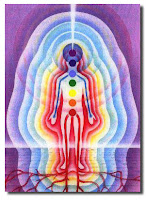The visual comparison of the main energy systems: Chakra system, Guna system and Ki system.More about guna system below
MORE ON THE INDIAN YOGIC SYSTEM OF THREE GUNAS
1. TAMAS - Darkness, stagnation
Symbolised by the colours black or dark-blue Tamas is a quality of
awareness reflecting the realm of latent, murky, obscured or ‘occult’
knowledge and power. In physical nature it finds expression as gravity
and inertial mass. In human nature it is felt essentially as a downward-
pulling sense of inertia and heaviness. If and when it dominates the
individual however, it may be experienced somatically as ‘fatigue’,
‘lethargy’ or ‘lack of energy’, experienced mentally and emotionally
as ‘dullness’ of mind, ‘negativity’ or ‘depression’, expressed outwardly
as ‘laziness’ or ‘sloth’, or embodied as physical weight or obesity. It
finds positive expression as dignified ‘gravitas’ or ‘groundedness’, as
depth or ‘weightiness’ of character, the ability to ‘bear’, ‘support’ or
‘pull’ weight and to sink one’s awareness down meditatively into the
depths of one’s body and being. Essentially it is potential action and
awareness experienced darkly or obscurely. Theologically it iis
associated with the primordial darkness and power of the primordial
mother goddess known as ‘The Great Black One’ (Maha-Kali).
Temperamentally it is the Guna uniting the ‘phlegmatic’ with the ‘black
bile’ of the ‘melancholic’. Anatomically and medically it is associated
with the bowels, abdomen and womb. Psychiatrically it is labelled as
mild or severe depression. Sociologically it can find negative expression
as the destructive potential of spiritual ignorance, generalised political
apathy, the dullness of routinised work, lack of empathy and lifeless
personal relationships. People search to compensate for Tamasic
existence either though Rajas - hyperactivity and busyness, revelry in
drugs and consumerism or mindless entertainment or through bland
Sattvic states of spiritual harmony, peace and calm.
2. RAJAS - Motion and passion
Symbolised by the colour red, Rajas has essentially to do with the
emergence of the vital impulses to outward action and motion (‘e-
motion’) that lay latent, obscured or blocked in Tamas. Rajas finds
expression as the very process of ‘emergence’ (Greek ‘Physis’) that is
the root meaning of the term ‘physical’, and with ‘energy’ in the root
sense of ‘action’ or ‘activity’ (energein). That is why the Rajas Guna is
principally associated with red-blooded vitality or passion, with the
impulse to act, and also hot-blooded anger and rage – with ‘seeing
red’, and with the aggression necessary to release blocked action or
communication. Temperamentally it is the Guna uniting the sanguine
with the choleric. Anatomically it is associated with the genitals and
heart, blood and menstruation, psychiatrically with mania and
paranoia. Sociologically it can find negative expression as rapacious
greed and pervades the active realms of sport, politics and business.
3. SATTVA - goodness, awarness and light
Symbolised by the colour white, Sattva is a reflection of the clear light
of awareness out of which alone truth, clear insight, direction and ‘right
action’ can arise. As a natural quality this Guna is associated with
radiance, light and lightness, and thereby also with the expansion and
expansiveness of space. Its root meaning is ‘being’ (Sat). This Guna is
favoured by many pseudo-spiritual types - being associated with
perfect ‘brightness’ of spirit, ‘balance’ and ‘well-being’. Yet the flip
side of the ‘balance’ or ‘well-being’ experienced through the Sattva
Guna can be a mere bland emotional equanimity, lack of empathy
and blankness of mind – albeit disguised as meditative ‘calm’ and
‘tranquillity’. Alternatively it finds expression as an idealisation of
asceticism and ‘spiritual’ transcendence at the expense of full-
blooded vitality, embodied presence and depth of soul. Just as ‘black’
is not intrinsically the colour of ‘evil’ so is white not intrinsically the colour
of ‘goodness’ and spiritual purity – for it is also the colour of fearful
pallor, of ghosts and skeletons - and, in the East, of death itself.
Temperamentally the Sattva Guna unites the phlegmatic with the
sanguine. Anatomically it is associated with the lymphatic and immune
systems, medically with anaemia and anorexia, and psychiatrically
with schizophrenia. Sociologically it is associated with the realm of
institutionalised religion and the search for inner peace and harmony
through ‘spirituality’. Commercial media advertisers are very keen and
clever exploiters of both the Sattva and Raja Gunas – whether it be
through emphasising the Rajasic qualities of such commodities as cars
or alcoholic drinks, or the Sattvic qualities of ‘well-being’ associated
with ‘healthy’ foods, cosmetics, over-the-counter medications etc.
By Peter Wilberg





































